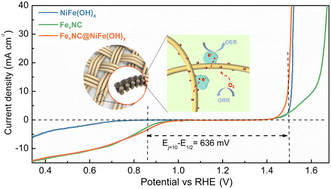File Download
There are no files associated with this item.
Links for fulltext
(May Require Subscription)
- Publisher Website: 10.1039/D2QI02564G
- Scopus: eid_2-s2.0-85148947557
- WOS: WOS:000944200000001
- Find via

Supplementary
- Citations:
- Appears in Collections:
Article: A Highly Durable Zinc-Air Battery from Directly Integrated FexNC@NiFe(OH)x Bifunctional Catalyst
| Title | A Highly Durable Zinc-Air Battery from Directly Integrated FexNC@NiFe(OH)x Bifunctional Catalyst |
|---|---|
| Authors | |
| Issue Date | 2-Feb-2023 |
| Publisher | Royal Society of Chemistry |
| Citation | Inorganic Chemistry Frontiers, 2023, v. 10, n. 6, p. 1758-1768 How to Cite? |
| Abstract | Rechargeable zinc-air batteries (ZABs) hold great promise for energy storage and conversion due to their high theoretical energy density, cost-effectiveness, and inherent safety. However, progress is constrained by sluggish oxygen electrocatalysis and instability at the air cathode. To address such issues, we resort to a directly integrated pseudo-3D composite electrocatalyst based on carbon cloth, on which Fe/Fe3C- and N- co-doped carbon nanotubes are directly induced and then used to further intercalate NiFe hydroxide clusters, FexNC@NiFe(OH)x. This hierarchical electrocatalyst shows enhanced oxygen electrocatalysis (ΔE is 636 mV), rendering high efficiency and durability of ZABs. Such improvement can be attributed to the rationally integrated pseudo-3D structure with high conductivity, high density of active sites, interconnected porosity, and well-bonded components for accelerating electron transfer and ion diffusion while ensuring structural integrity. Moreover, the hierarchical structure increases the electrochemical surface area with superior surface hydrophilicity. As a result, the composite electrocatalyst shows great potential as a binder-free air electrode, as demonstrated in a rechargeable ZAB of a high power density of 85.1 mW cm−2 and a long period of operation beyond 2000 cycles (350 h) without notable degradation, outperforming noble metal electrodes.
|
| Persistent Identifier | http://hdl.handle.net/10722/341633 |
| ISSN | 2023 Impact Factor: 6.1 2023 SCImago Journal Rankings: 1.255 |
| ISI Accession Number ID |
| DC Field | Value | Language |
|---|---|---|
| dc.contributor.author | Luo, Hao | - |
| dc.contributor.author | Li, Yang | - |
| dc.contributor.author | Wang, Wenchao | - |
| dc.contributor.author | Zhou, Tao | - |
| dc.contributor.author | Guo, Zhengxiao | - |
| dc.date.accessioned | 2024-03-20T06:57:54Z | - |
| dc.date.available | 2024-03-20T06:57:54Z | - |
| dc.date.issued | 2023-02-02 | - |
| dc.identifier.citation | Inorganic Chemistry Frontiers, 2023, v. 10, n. 6, p. 1758-1768 | - |
| dc.identifier.issn | 2052-1553 | - |
| dc.identifier.uri | http://hdl.handle.net/10722/341633 | - |
| dc.description.abstract | <p>Rechargeable zinc-air batteries (ZABs) hold great promise for energy storage and conversion due to their high theoretical energy density, cost-effectiveness, and inherent safety. However, progress is constrained by sluggish oxygen electrocatalysis and instability at the air cathode. To address such issues, we resort to a directly integrated pseudo-3D composite electrocatalyst based on carbon cloth, on which Fe/Fe<small><sub>3</sub></small>C- and N- co-doped carbon nanotubes are directly induced and then used to further intercalate NiFe hydroxide clusters, Fe<small><sub><em>x</em></sub></small>NC@NiFe(OH)<small><sub><em>x</em></sub></small>. This hierarchical electrocatalyst shows enhanced oxygen electrocatalysis (Δ<em>E</em> is 636 mV), rendering high efficiency and durability of ZABs. Such improvement can be attributed to the rationally integrated pseudo-3D structure with high conductivity, high density of active sites, interconnected porosity, and well-bonded components for accelerating electron transfer and ion diffusion while ensuring structural integrity. Moreover, the hierarchical structure increases the electrochemical surface area with superior surface hydrophilicity. As a result, the composite electrocatalyst shows great potential as a binder-free air electrode, as demonstrated in a rechargeable ZAB of a high power density of 85.1 mW cm<small><sup>−2</sup></small> and a long period of operation beyond 2000 cycles (350 h) without notable degradation, outperforming noble metal electrodes.</p><p><img src="https://pubs.rsc.org/en/Image/Get?imageInfo.ImageType=GA&imageInfo.ImageIdentifier.ManuscriptID=D2QI02564G&imageInfo.ImageIdentifier.Year=2023" alt="Graphical abstract: A highly durable zinc-air battery from a directly integrated FexNC@NiFe(OH)x bifunctional catalyst"></p> | - |
| dc.language | eng | - |
| dc.publisher | Royal Society of Chemistry | - |
| dc.relation.ispartof | Inorganic Chemistry Frontiers | - |
| dc.rights | This work is licensed under a Creative Commons Attribution-NonCommercial-NoDerivatives 4.0 International License. | - |
| dc.title | A Highly Durable Zinc-Air Battery from Directly Integrated FexNC@NiFe(OH)x Bifunctional Catalyst | - |
| dc.type | Article | - |
| dc.identifier.doi | 10.1039/D2QI02564G | - |
| dc.identifier.scopus | eid_2-s2.0-85148947557 | - |
| dc.identifier.volume | 10 | - |
| dc.identifier.issue | 6 | - |
| dc.identifier.spage | 1758 | - |
| dc.identifier.epage | 1768 | - |
| dc.identifier.eissn | 2052-1553 | - |
| dc.identifier.isi | WOS:000944200000001 | - |
| dc.identifier.issnl | 2052-1545 | - |


